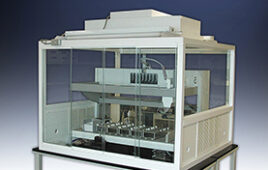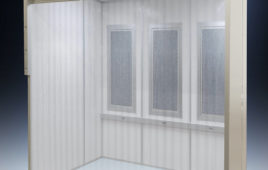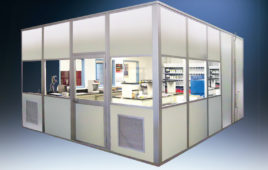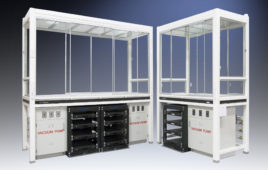Particles smaller than 10 microns may be invisible to the human eye, but their presence can prove hazardous in the manufacture of parenterals and other biotech products- so hazardous, in fact, that the FDA’s aeseptic processing guidelines mandate a minimum Class 100(ISO 5) cleanroom for critical areas, which are defined as anywhere parenterals may be exposed.
Further, the critical areas must be supported by a minimum Class 10,000 (ISO 7) cleanroom throughout the rest of the controlled facility although many manufacturers today are even opting for the stricter Class 1,000 (ISO 6). Under the burden of such heavy regulations—not to mention the threat of personnel and end-user safety risks—parenteral manufacturers must continuously evaluate their housekeeping regimens to ensure that all controlled areas are properly cleaned and maintained. The first step in any such evaluation is to scrutinize the most critical cleaning function carried out in biotech and other cleanrooms: vacuuming.
Vacuuming with cleanroom-compatible machines designed specifically to collect and retain microscopic particles enables you to prevent airborne particulate contamination, ensure air and product purity, and safeguard the health of employees.
To fully realize these benefits one must ask some key questions:
-
What are the most common cleanroom contaminants in biotech facilities? How can they be prevented from entering the cleanroom?
-
How do other cleanroom cleaning methods stack up against vacuuming?
-
Which is best—a central system, several portable vacuums, or a combination of both?
Keeping Contaminants Out
First, let’s take a look at common cleanroom contaminants and how they can be prevented from entering the cleanroom in the first place. Contaminants are typically generated by two major sources: materials/equipment and cleanroom personnel (see Figure 1).
Materials and Equipment. Cleanroom consumables such as gloves, masks, wipers, swabs, hairnets, booties, HEPA filters, and tacky mats can be breeding grounds for contaminants if the proper preventive measures aren’t taken. For example, if employees don’t decontaminate their gloves before entering the cleanroom, everything they touch may be contaminated, including the finished product. Because the cost of repairing such damage can be exorbitant, it is vital that all consumables be thoroughly decontaminated with an alcohol wipe-down prior to cleanroom use.
Another potential source of contamination is the equipment already found within the cleanroom. The vibration of this equipment alone is often enough to cause a breakdown of particles, which then circulate in the ambient air.
The most efficient way to prevent this type of contamination is to keep all machinery as dust-free as possible. Toward that end, a HEPA-filtered vacuum and traditional wipe-down methods should be used to clean and decontaminate all machinery and attachments.
Cleanroom Personnel. One of the most common, and hard to control, cleanroom contaminants is people. While cleanroom gowns and other garments are designed to limit human contamination, it is impossible to regulate uncontrollable actions like sneezing and coughing. The typical operator generates approximately 1 million organic airborne particles >0.5 microns per minute. To help reduce human-generated contamination, instruct personnel on proper hygiene procedures and the importance of limiting motions, such as the swinging of arms or fast walking.1
Cleaning Methods for Proper Maintenance
Due to the inevitable particulates generated by consumables, equipment, and personnel, parenteral manufacturers must find the most effective methods for removing them from the cleanroom. This is especially important in biotech cleanrooms, where highly toxic materials and organisms are often handled. It is the manufacturer’s duty to protect both its product and employees from contaminating each other—and the environment.
Simply put, every square inch of the biotech cleanroom should be absolutely pure. Ceiling panels, lighting units, HEPA filtration units, sprinkler heads, walls, glass surfaces, process equipment, piping systems, floors, and manufacturing equipment should all be decontaminated regularly. Even the ambient air must be monitored and maintained at proper levels. HEPA-filtered ventilation systems, assisted by the preventative measures outlined previously, help manufacturers limit airborne contamination. However, in order to assure environmental purity, regular housecleaning procedures are necessary.
Cleaning with both a HEPA-filtered vacuum and traditional wipe-down methods are standard housekeeping procedures in most biotech cleanrooms. Yet in critical cleaning situations, vacuuming is often the more efficient method because particles are retained inside the machine with little chance of being exhausted into the atmosphere (provided your vacuum has a HEPA-filtered exhaust stream).
Vacuuming also eliminates fiber particles that swabs and wipers may leave behind. In fact, measurements taken in one cleanroom setting found that a dusting system using disposable cloths polluted the space twice as much as a system using a HEPA-filtered vacuum cleaner. Table 1 shows a short list of suggestions for helping to keep cleanrooms contaminant-free.

What To Look for in a Vacuum
First and foremost, any vacuum cleaner used in a biotech parenteral cleanroom must be HEPA-filtered to ensure that 99.97% of all particles down to and including 0.3 microns are collected and retained. In addition, it is absolutely critical that the HEPA filter be installed after the motor to filter the exhaust stream. The motor’s commutator and carbon brushes generate dust, and if the exhaust stream is not filtered that dust will be released into the environment.


A word of caution: not all HEPA-filtration systems are created equal. Make sure the vacuum you select contains a multi-stage, graduated filtration system for peak operating efficiency. A graduated filtration system uses a series of progressively finer filters to trap and retain particles as they move through the vacuum. The largest particles are captured first by coarser filters; smaller particles are then caught and retained by the finer HEPA filters. This multi-stage system protects the HEPA filters from blockage and excessive wear-and-tear, maintaining peak performance. (When equipped with an ULPA filter, the system should retain up to 99.999% of all ultra-fine particles, down to and including 0.12 microns in size).
Additionally, the filtration system in the vacuum should use oversized filters that slow airflow across the larger surface area and optimize the air-to-cloth ratio. This allows the vacuum to easily collect large volumes of debris over extended periods of time with minimal maintenance.
Besides having an exceptional filtration system, any vacuum used in a biotech cleanroom should be constructed of non-particle-generating materials. For example, stainless steel vacuums equipped with smooth hoses and attachments enable personnel to quickly wipe down and decontaminate equipment for faster, simpler sanitization and validation. Tip: Don’t forget to take spill response into account when purchasing a vacuum. At least one of your vacuums should be capable of wet and dry collection.
Central Systems vs. Portable Vacuums
An ongoing debate among parenteral manufacturers, and other manufacturers who work within cleanroom environments, is whether a central vacuum system or several portable vacuum cleaners are most efficient. See Table 2 and decide which will work best in your application. Ideally, a biotech cleanroom should offer both vacuum options. Personnel can then determine which vacuum is best for the task at hand, based on the specific application.
Preparing for The Future
The outdated U.S. Federal Standard 209E (FS209E), which has regulated cleanroom operations since 1963, was replaced as of November 2001. Stricter regulations, set forth by the International Organization for Standardization (ISO), have been adopted by the European Union, the U.S., and across much of the industrialized world. ISO’s new standard, ISO 14644-1, defines the criteria that cleanrooms must meet to stay competitive in today’s global business environment.
Now is the time for parenteral and other biotech manufacturers to turn a critical eye towards cleanroom housekeeping procedures. By considering the important topics broached here, you can evaluate your facilities, identify areas where improvement is needed, and meet the new regulations head-on with an exceptionally efficient cleanroom environment.
For Futher Reading
1 Additional guidelines for preventing contamination with proper personnel training can be found in the FDA’s Quality System Manual at www.fda.gov/cdrh/qsr/05prsnl.html




